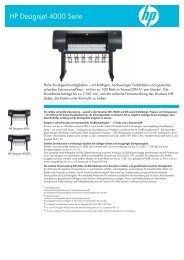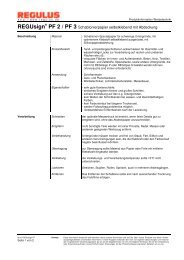STOCHASTIC HALFTONE SCREENING
STOCHASTIC HALFTONE SCREENING
STOCHASTIC HALFTONE SCREENING
Create successful ePaper yourself
Turn your PDF publications into a flip-book with our unique Google optimized e-Paper software.
C G T T E C H N I C A L P U B L I C A T I O N S<br />
No matter how careful you are, circumstances<br />
beyond your control will lead to<br />
the localized generation of a moiré pattern<br />
in the image.<br />
Moiré is nothing more than repetitive<br />
interference patterns. To eliminate them,<br />
we must eliminate the interference or<br />
eliminate the repetition. This is where<br />
stochastic halftoning really has an advantage.<br />
Since dots are randomly distributed,<br />
there is very little chance that a regular<br />
pattern will form. We essentially eliminate<br />
repetition of the dot patterns. We cannot<br />
completely eliminate interference of the<br />
mesh with the dot, but we can eliminate<br />
the repetition. This effectively cancels the<br />
formation of the moiré. The randomness<br />
of the dot generation neutralizes mesh-todot,<br />
dot-to-dot, dot-to-substrate, and<br />
printed-dot-to-printed-dot (cross moiré in<br />
UV) moiré.<br />
Placement of the halftone image on the<br />
screen is not critical. Unlike conventional<br />
halftones where halftone angle is of<br />
primary concern, stochastic halftones are<br />
not sensitive to positioning on the mesh. If<br />
anything, the only angle that they are<br />
sensitive to is 0 o or 90 o . This relieves the<br />
screen maker of the responsibility of<br />
precise placement on the mesh. Likewise,<br />
there is no need to consider biasing the<br />
screen mesh to the frame.<br />
While it may appear that it is possible to<br />
completely eliminate moiré with stochastic<br />
screening, this is not entirely true. We<br />
must remember that all digital imaging is<br />
conducted on the X-Y grid axis of the laser<br />
imagesetter. No matter how random the<br />
appearance of the halftone generated, the<br />
imagesetter grid is still there. In controlled<br />
tests we have been able to make random<br />
dot halftones moiré at specific dot sizes on<br />
specific mesh counts. This is very useful<br />
because the moiré is always “global”,<br />
meaning that it is everywhere. You either<br />
get it or you don’t. It also helps the<br />
halftone designer avoid specific relationships<br />
that will cause a problem. It is now<br />
possible to “engineer” a halftone solution<br />
to a specific mesh with a very high probability<br />
(greater than 99.9%) of moiré-free<br />
imaging.<br />
Limitations<br />
Stochastic halftones are not free of<br />
limitations. Like most processes involved<br />
with screen printing, it is a series of<br />
compromises. These compromises simply<br />
help to define when and where to use this<br />
type of halftone method. Most of these<br />
considerations will diminish with time as<br />
further development continues.<br />
Currently the size of the stochastic dot is<br />
a problem. At this time I am aware of only<br />
one product that allows for specific<br />
selection of the size of the stochastic dot.<br />
All of the other products use the laser spot<br />
size as the governing method for the<br />
generation of halftone dot size. This limits<br />
the dot size to 7, 14, or 20 microns.<br />
Virtually all of the stochastic halftone<br />
programs are geared for lithographic and<br />
gravure printing. Even at that, printers are<br />
having difficulty handling these very small<br />
dots. By the time you read this, there may<br />
very well be other products that will work<br />
for screen printing.<br />
The halftoning takes place at the Raster<br />
Image Processing (RIP) stage. The RIP<br />
may be either hardware-based or softwarebased.<br />
The greatest availability of FM<br />
halftoning is imagesetter specific. This<br />
means that Agfa software must run on<br />
Agfa equipment and a Linotype product<br />
must run on Linotronic imagesetters. This<br />
is because of the intensive calculations that<br />
must be optimized to keep the RIP<br />
processing time at a reasonable minimum.<br />
To afford the luxury of working with<br />
any imagesetter, stochastic halftoning<br />
would need to be done on a software RIP.<br />
TECH LIBRARY<br />
ONLINE<br />
TECHNICAL<br />
SUPPORT<br />
©1994 Coudray Graphic Technologies :: 805.541.1521 <strong>STOCHASTIC</strong> <strong>HALFTONE</strong> <strong>SCREENING</strong><br />
5
















